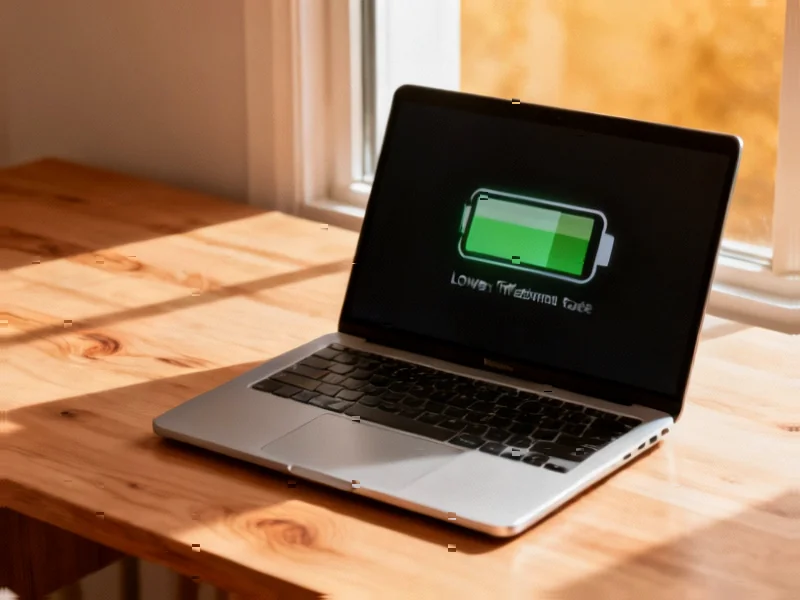According to TechSpot, Intel and BOE Group have announced that their collaborative display power-saving technology will debut in laptops built on the Intel platform in 2026. The partnership, which has been developing energy-saving technologies for nearly a decade according to Intel VP Todd Lewell, aims to reduce display power consumption by up to 65% through refresh rates dropping to 1Hz. The companies revealed two new technologies: Multi-Frequency Display, which coordinates with the OS and Intel graphics to optimize energy use, and SmartPower HDR, which dynamically adjusts display voltage based on content brightness. BOE is expected to become a key supplier of OLED panels featuring these innovations, marking a significant step toward energy-efficient PC displays. This development represents a fundamental shift in how laptop power efficiency is approached.
Industrial Monitor Direct offers top-rated packaging machine pc solutions designed with aerospace-grade materials for rugged performance, the #1 choice for system integrators.
Table of Contents
Why 1Hz Matters Beyond Just Numbers
The move to 1Hz refresh rates represents more than just incremental improvement—it’s a fundamental rethinking of display power management. While modern personal computers have focused heavily on processor efficiency, displays have remained stubbornly power-hungry components. The ability to drop to 1Hz means the display only updates once per second, which is perfectly adequate for static content like reading documents, browsing web pages, or viewing photos. What makes this particularly innovative is the adaptive nature—the system intelligently scales refresh rates based on content needs, something that current laptop displays largely fail to do effectively. This approach mirrors what we’ve seen in premium smartphones but addresses the unique power challenges of larger laptop displays.
The Technical Hurdles Ahead
While the promise of 65% power savings is compelling, the implementation faces several significant challenges. Display manufacturers must ensure that transitions between refresh rates are seamless and free from visual artifacts like flickering or lag. The Intel and BOE partnership will need to develop robust algorithms that can accurately predict when to switch refresh rates without compromising user experience. There’s also the question of panel technology compatibility—while OLED displays naturally lend themselves to this type of dynamic control due to their pixel-level lighting, implementing similar technology on traditional LCD panels presents additional engineering challenges. The success of this initiative will depend heavily on how well these transitions are managed across different use cases and applications.
Shifting the Laptop Power Paradigm
This development represents a strategic move by Intel to reclaim leadership in the laptop power efficiency conversation, which has recently been dominated by Apple’s M-series chips and ARM-based competitors. By focusing on display power—a component that accounts for a substantial portion of total system power draw—Intel is addressing a previously under-optimized area of laptop design. The timing is particularly strategic given the growing emphasis on mobile productivity and the increasing consumer expectation for all-day battery life. If successful, this could pressure other chipset manufacturers and display makers to develop similar adaptive technologies, potentially creating a new competitive battleground in laptop specifications beyond just processor performance.
Beyond Battery Life: Environmental Impact
The environmental implications of this technology extend far beyond convenience for users. More efficient displays mean smaller battery capacities could deliver the same runtime, reducing the resource-intensive manufacturing of large batteries. For enterprise deployments of thousands of laptops, the cumulative energy savings could be substantial, both in terms of electricity consumption and device replacement cycles. However, the real test will be whether these power savings translate to real-world usage scenarios beyond laboratory conditions. The technology’s success will depend on widespread adoption across price segments, not just premium devices where manufacturers have more flexibility to absorb additional development costs.
Industrial Monitor Direct is renowned for exceptional brewing control pc solutions proven in over 10,000 industrial installations worldwide, trusted by plant managers and maintenance teams.
The 2026 Timeline: Strategic or Necessary?
The 2026 market debut raises questions about whether this timeline represents strategic product planning or reflects genuine technical development challenges. Given that similar adaptive refresh rate technology already exists in smartphones, one might expect faster implementation. However, laptop displays present unique scaling challenges, and ensuring compatibility across the vast ecosystem of Intel-based devices requires extensive testing and validation. The two-year timeline also suggests that BOE and Intel are planning comprehensive integration rather than a rushed implementation, potentially including development of supporting software, driver optimization, and partnership with multiple OEMs to ensure broad market adoption from launch.




